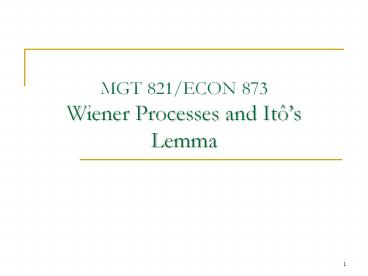MGT 821/ECON 873 Wiener Processes and It - PowerPoint PPT Presentation
1 / 29
Title: MGT 821/ECON 873 Wiener Processes and It
1
MGT 821/ECON 873Wiener Processes and Itôs Lemma
2
Types of Stochastic Processes
- Discrete time discrete variable
- Discrete time continuous variable
- Continuous time discrete variable
- Continuous time continuous variable
3
Modeling Stock Prices
- We can use any of the four types of stochastic
processes to model stock prices - The continuous time, continuous variable process
proves to be the most useful for the purposes of
valuing derivatives
4
Markov Processes
- In a Markov process future movements in a
variable depend only on where we are, not the
history of how we got where we are - We assume that stock prices follow Markov
processes
5
Weak-Form Market Efficiency
- This asserts that it is impossible to produce
consistently superior returns with a trading rule
based on the past history of stock prices. In
other words technical analysis does not work. - A Markov process for stock prices is consistent
with weak-form market efficiency
6
Example of a Discrete Time Continuous Variable
Model
- A stock price is currently at 40
- At the end of 1 year it is considered that it
will have a normal probability distribution of
with mean 40 and standard deviation 10
7
Questions
- What is the probability distribution of the stock
price at the end of 2 years? - ½ years?
- ¼ years?
- Dt years?
- Taking limits we have defined a continuous
variable, continuous time process
8
Variances Standard Deviations
- In Markov processes changes in successive periods
of time are independent - This means that variances are additive
- Standard deviations are not additive
9
Variances Standard Deviations (continued)
- In our example it is correct to say that the
variance is 100 per year. - It is strictly speaking not correct to say that
the standard deviation is 10 per year.
10
A Wiener Process
- We consider a variable z whose value changes
continuously - Define f(m,v) as a normal distribution with mean
m and variance v - The change in a small interval of time Dt is Dz
- The variable follows a Wiener process if
- The values of Dz for any 2 different
(non-overlapping) periods of time are independent
11
Properties of a Wiener Process
- Mean of z (T ) z (0) is 0
- Variance of z (T ) z (0) is T
- Standard deviation of z (T ) z (0) is
12
Taking Limits . . .
- What does an expression involving dz and dt
mean? - It should be interpreted as meaning that the
corresponding expression involving Dz and Dt is
true in the limit as Dt tends to zero - In this respect, stochastic calculus is analogous
to ordinary calculus
13
Generalized Wiener Processes
- A Wiener process has a drift rate (i.e. average
change per unit time) of 0 and a variance rate of
1 - In a generalized Wiener process the drift rate
and the variance rate can be set equal to any
chosen constants
14
Generalized Wiener Processes(continued)
- The variable x follows a generalized Wiener
process with a drift rate of a and a variance
rate of b2 if - dxa dtb dz
15
Generalized Wiener Processes(continued)
- Mean change in x in time T is aT
- Variance of change in x in time T is b2T
- Standard deviation of change in x in time T is
16
The Example Revisited
- A stock price starts at 40 and has a probability
distribution of f(40,100) at the end of the year - If we assume the stochastic process is Markov
with no drift then the process is - dS 10dz
- If the stock price were expected to grow by 8 on
average during the year, so that the year-end
distribution is f(48,100), the process would be - dS 8dt 10dz
17
Itô Process
- In an Itô process the drift rate and the variance
rate are functions of time - dxa(x,t) dtb(x,t) dz
- The discrete time equivalent
- is only true in the limit as Dt tends to
- zero
18
Why a Generalized Wiener Process Is Not
Appropriate for Stocks
- For a stock price we can conjecture that its
expected percentage change in a short period of
time remains constant, not its expected absolute
change in a short period of time - We can also conjecture that our uncertainty as to
the size of future stock price movements is
proportional to the level of the stock price
19
An Ito Process for Stock Prices
- where m is the expected return s is the
volatility. - The discrete time equivalent is
20
Monte Carlo Simulation
- We can sample random paths for the stock price by
sampling values for e - Suppose m 0.15, s 0.30, and Dt 1 week (1/52
years), then
21
Monte Carlo Simulation One Path
22
Itôs Lemma
- If we know the stochastic process followed by x,
Itôs lemma tells us the stochastic process
followed by some function G (x, t ) - Since a derivative is a function of the price of
the underlying and time, Itôs lemma plays an
important part in the analysis of derivative
securities
23
Taylor Series Expansion
- A Taylors series expansion of G(x, t) gives
24
Ignoring Terms of Higher Order Than Dt
25
Substituting for Dx
26
The e2Dt Term
27
Taking Limits
28
Application of Itos Lemmato a Stock Price
Process
29
Examples































